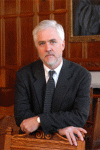Gregory McCarthy, Ph.D.
Biography
I received my Ph.D. in Biological Psychology from the University of Illinois in Champaign-Urbana. My main advisor was Professor Emanuel Donchin and my committee consisted of Michael G.H. Coles, William Greenough, and Charles Eriksen. My thesis concerned the manner in which electrophysiological recordings could complement the measurement of reaction time in simple decision tasks by providing information about the timing of component mental and neural processes.
After graduate school, I moved to Yale University and the West Haven VA Medical Center to work at the Neuropsychology Laboratory with Truett Allison, Bill Goff, Terry Darcey and Charles C. Wood on a broad range of electrophysiological studies in both animals and humans. It was with Truett Allison and a wonderful group of post-doctoral and graduate students including Shlomo Bentin, Anna Nobre, Ken Paller, Aina Puce, and Aysenil Belger that I explored human brain systems involved in face and letterstring processing, language processing, decision-making, memory, and basic sensory and motor processing.
As an Assistant and then Associate Professor in Yale’s Department of Neurosurgery, I enjoyed a long and productive association with Dr. Dennis Spencer, its chair, and the Yale Epilepsy Surgery Program. With Spencer, I started exploring the structural changes that occurred in patients with temporal lobe epilepsy with a focus on the hippocampus. These studies involved making quantitative measurements with MRI, which at the time was a relatively new technique that we had adopted for the placement of intracranial electrodes. The structural MRI work led to some interesting observations of hippocampal atrophy in epilepsy, and to the relationship of atrophy to memory deficits in epilepsy. Doug Bremner, a psychiatrist working with the support of a VA Career Development award and Tammy Scott, a Yale graduate student working in my lab, began to apply these same techniques to patients with PTSD and found both memory deficits and hippocampal atrophy in this population.
These studies stimulated my interest in MRI and in 1992 I joined began a collaboration with Robert Shulman’s lab at Yale that resulted in several of the earliest functional MRI studies, including the first that explicitly manipulated cognitive processes. An exciting and productive period ensued in which my group worked with many collaborators including John Gore and Todd Constable to investigate sensory and motor processes, language, motion, and working memory with fMRI. One area of particular interest in our group was face processing, in which our initial observations of face specific regions in the fusiform gyrus defined by electrical recording and stimulation in humans was quickly followed by the first fMRI studies of face processing that we published in 1995.
In 1998 I left Yale to become the founding director of the Brain Imaging and Analysis Center (BIAC) at Duke University. At Duke I was very fortunate to work with outstanding colleagues such as Allen Song, and to have an outstanding series of post-docs, K-award trainees, and graduate students including Scott Huettel, Kevin Pelphrey, Eiji Kirino, Hiroshi Yamasaki, Lihong Wang, Sean Hinton, Raj Morey, Michele Diaz, Florin Dolcos, and James Morris. At the BIAC, I was able to expand my interests in social perception, and to more fully develop a nascent line of research that I had begun at Yale on social perception and biological motion, which remains a significant aspect of my current research. I was also able to develop a new line of research on the interplay of emotion regulation and executive processing, which had grown from earlier studies at Yale on working memory and executive processing that I had done in collaboration with Patricia Goldman-Rakic.
This latter series of studies also led me into a clinical line of research in depression and PTSD. In 2003, I became the founding director of the Veterans Administration’s VISN6 Mental Illness Research, Education, and Clinical Center (MIRECC), which focused upon genetic, neuroimaging, neuropsychological, and intervention studies of mental disorders that followed deployment of soldiers to Iraq and Afghanistan. My own research within the MIRECC has focused upon imaging genetics in PTSD, and has been conducted in collaboration with Raj Morey, Chris Marx, and Jean Beckham.
I returned to Yale as Professor in the Department of Psychology in 2006. After nearly a decade away from New Haven, I was extraordinarily pleased to be back and am enjoying the new experience of being an Arts and Sciences faculty member. My new laboratory is focused upon social perception, emotional regulation, and cognitive control. I approach these issues using intracranial EEG/ERP, scalp EEG/ERP, functional MRI, eye tracking, and psychophysiology. I was lucky to have Andrew Engell join my lab as a post-doc and was happy for him, but sad for the lab, when he started his own lab this year as an Assistant Professor at Kenyon College. I have also been very pleased to have a great group of graduate students complete their dissertations in this new lab including Sarah Shultz, Andrea Gold, Elise Christopher, and Yi He. One of the joys of working at Yale Psychology is the cross-mentoring of students across the different labs, and so I have also been able to work closely with other graduates of our program including Nick Turk-Browne, Tao Gao, and Julie Golomb. I have also maintained many of the collaborations that I established at the Duke and at the VA, and maintain a strong relationship with the imaging group at the VISN6 MIRECC.
